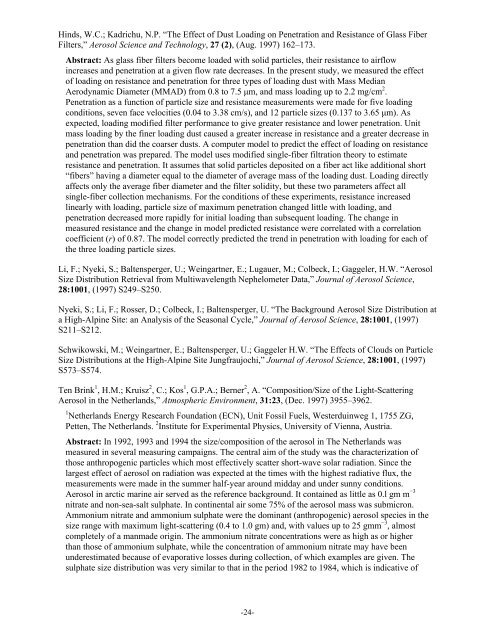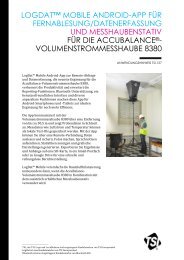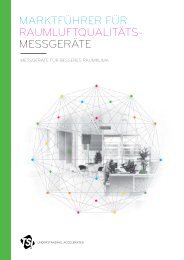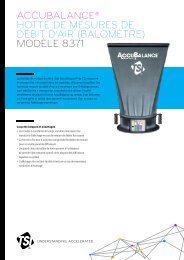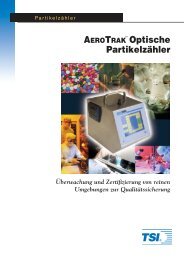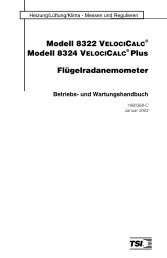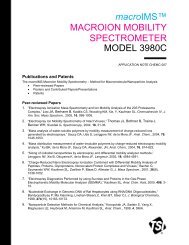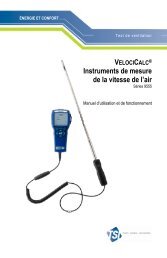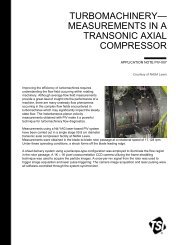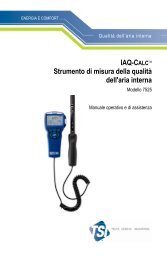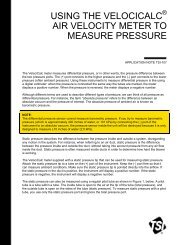Model 3340 Laser Aerosol Spectrometer Bibliography - Tsi
Model 3340 Laser Aerosol Spectrometer Bibliography - Tsi
Model 3340 Laser Aerosol Spectrometer Bibliography - Tsi
Create successful ePaper yourself
Turn your PDF publications into a flip-book with our unique Google optimized e-Paper software.
Hinds, W.C.; Kadrichu, N.P. “The Effect of Dust Loading on Penetration and Resistance of Glass Fiber<br />
Filters,” <strong>Aerosol</strong> Science and Technology, 27 (2), (Aug. 1997) 162–173.<br />
Abstract: As glass fiber filters become loaded with solid particles, their resistance to airflow<br />
increases and penetration at a given flow rate decreases. In the present study, we measured the effect<br />
of loading on resistance and penetration for three types of loading dust with Mass Median<br />
Aerodynamic Diameter (MMAD) from 0.8 to 7.5 μm, and mass loading up to 2.2 mg/cm 2 .<br />
Penetration as a function of particle size and resistance measurements were made for five loading<br />
conditions, seven face velocities (0.04 to 3.38 cm/s), and 12 particle sizes (0.137 to 3.65 μm). As<br />
expected, loading modified filter performance to give greater resistance and lower penetration. Unit<br />
mass loading by the finer loading dust caused a greater increase in resistance and a greater decrease in<br />
penetration than did the coarser dusts. A computer model to predict the effect of loading on resistance<br />
and penetration was prepared. The model uses modified single-fiber filtration theory to estimate<br />
resistance and penetration. It assumes that solid particles deposited on a fiber act like additional short<br />
“fibers” having a diameter equal to the diameter of average mass of the loading dust. Loading directly<br />
affects only the average fiber diameter and the filter solidity, but these two parameters affect all<br />
single-fiber collection mechanisms. For the conditions of these experiments, resistance increased<br />
linearly with loading, particle size of maximum penetration changed little with loading, and<br />
penetration decreased more rapidly for initial loading than subsequent loading. The change in<br />
measured resistance and the change in model predicted resistance were correlated with a correlation<br />
coefficient (r) of 0.87. The model correctly predicted the trend in penetration with loading for each of<br />
the three loading particle sizes.<br />
Li, F.; Nyeki, S.; Baltensperger, U.; Weingartner, E.; Lugauer, M.; Colbeck, I.; Gaggeler, H.W. “<strong>Aerosol</strong><br />
Size Distribution Retrieval from Multiwavelength Nephelometer Data,” Journal of <strong>Aerosol</strong> Science,<br />
28:1001, (1997) S249–S250.<br />
Nyeki, S.; Li, F.; Rosser, D.; Colbeck, I.; Baltensperger, U. “The Background <strong>Aerosol</strong> Size Distribution at<br />
a High-Alpine Site: an Analysis of the Seasonal Cycle,” Journal of <strong>Aerosol</strong> Science, 28:1001, (1997)<br />
S211–S212.<br />
Schwikowski, M.; Weingartner, E.; Baltensperger, U.; Gaggeler H.W. “The Effects of Clouds on Particle<br />
Size Distributions at the High-Alpine Site Jungfraujochi,” Journal of <strong>Aerosol</strong> Science, 28:1001, (1997)<br />
S573–S574.<br />
Ten Brink 1 , H.M.; Kruisz 2 , C.; Kos 1 , G.P.A.; Berner 2 , A. “Composition/Size of the Light-Scattering<br />
<strong>Aerosol</strong> in the Netherlands,” Atmospheric Environment, 31:23, (Dec. 1997) 3955–3962.<br />
1<br />
Netherlands Energy Research Foundation (ECN), Unit Fossil Fuels, Westerduinweg 1, 1755 ZG,<br />
Petten, The Netherlands. 2 Institute for Experimental Physics, University of Vienna, Austria.<br />
Abstract: In 1992, 1993 and 1994 the size/composition of the aerosol in The Netherlands was<br />
measured in several measuring campaigns. The central aim of the study was the characterization of<br />
those anthropogenic particles which most effectively scatter short-wave solar radiation. Since the<br />
largest effect of aerosol on radiation was expected at the times with the highest radiative flux, the<br />
measurements were made in the summer half-year around midday and under sunny conditions.<br />
<strong>Aerosol</strong> in arctic marine air served as the reference background. It contained as little as 0.l gm m −3<br />
nitrate and non-sea-salt sulphate. In continental air some 75% of the aerosol mass was submicron.<br />
Ammonium nitrate and ammonium sulphate were the dominant (anthropogenic) aerosol species in the<br />
size range with maximum light-scattering (0.4 to 1.0 gm) and, with values up to 25 gmm −3 , almost<br />
completely of a manmade origin. The ammonium nitrate concentrations were as high as or higher<br />
than those of ammonium sulphate, while the concentration of ammonium nitrate may have been<br />
underestimated because of evaporative losses during collection, of which examples are given. The<br />
sulphate size distribution was very similar to that in the period 1982 to 1984, which is indicative of<br />
-24-


